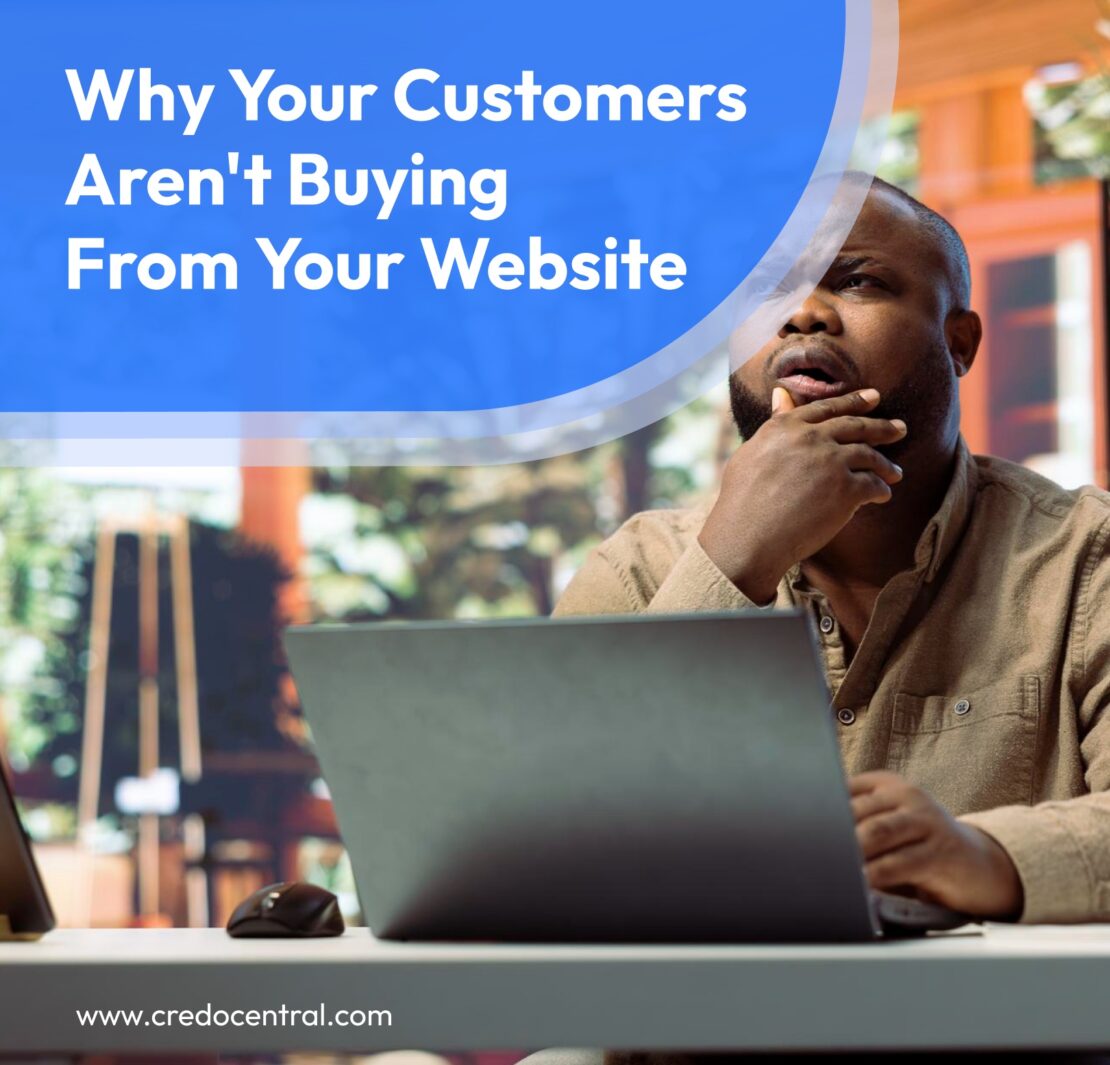Why Aren’t Your Customers Buying From Your Website?
Imagine this: You’ve spent countless hours crafting the perfect product, designing a stunning website, and investing your hard-earned money in marketing campaigns. Yet, despite all that effort, the sales just aren’t coming in. It’s frustrating, right? You’re probably asking yourself, “What’s going on? Where are all the customers?”
The reality is, simply having a website doesn’t guarantee sales. Just because your business has an online presence doesn’t mean customers will automatically flock to it. There are several reasons why your customers might be adding items to their cart, only to abandon them at the last minute. It’s not always about the product itself or even your marketing efforts; sometimes, the problem lies in the customer’s experience on your website.
Let’s dive into some common issues that might be causing your customers to walk away and, more importantly, how you can fix them.
1. Subpar User Experience: The Silent Sales Killer

First things first, let’s talk about user experience (UX). This is a big deal. If your website is difficult to navigate, slow to load, or doesn’t clearly showcase your products, customers will quickly lose interest. Think about it—when was the last time you stuck around on a website that was frustrating to use? Exactly.
For small businesses in Nigeria, where the competition is tough, a subpar user experience can be a silent sales killer. It’s not enough to have a website that looks good; it also needs to work well. If your site is clunky or confusing, potential customers will likely bounce before they even get a chance to see what you’re offering.
What You Can Do:
- Prioritize User-Friendliness: Your website should be easy to navigate. That means clear menus, logical categories, and an intuitive layout. Make it easy for customers to find what they’re looking for.
- Optimize for Mobile: More and more shoppers in Nigeria are browsing and buying on their phones. If your website isn’t mobile-friendly, you’re missing out on a huge chunk of potential sales. Ensure that your site is responsive, meaning it adjusts seamlessly to different screen sizes.
- Improve Load Times: Slow websites are a major turn-off. If your pages take forever to load, customers won’t stick around. Invest in good hosting, compress your images, and minimize any unnecessary plugins that might be slowing things down.
- Showcase Products Clearly: Use high-quality images and detailed descriptions. Let your customers see what they’re buying. The clearer and more appealing your product presentation, the more likely customers are to make a purchase.
2. Lack of Trust: The Online Buyer’s Dilemma
Trust is everything in online shopping. If customers don’t trust your website, they won’t buy from you—simple as that. With the rise of online scams, especially in Nigeria, customers are understandably cautious about where they spend their money.
If your website doesn’t seem trustworthy, if it looks sketchy or if there are no signs of security, customers will hesitate to complete their purchases. Even if they’ve already added items to their cart, they might abandon the checkout process if they don’t feel secure.
What You Can Do:
- Display Trust Badges: Trust badges are those little icons that show your website is secure. They can include things like SSL certificates, payment provider logos, and other security certifications. Place these badges prominently on your site, especially on checkout pages.
- Show Customer Reviews: Word-of-mouth is powerful. Displaying customer reviews and testimonials can significantly boost trust. If others have had a good experience with your business, new customers will feel more confident in making a purchase.
- Offer Multiple Payment Options: Customers like having choices, especially when it comes to payment methods. Offering multiple options like bank transfers, mobile payments, and credit cards can make your site feel more legitimate and user-friendly.
- Simplify the Checkout Process: A complicated checkout process can scare customers away. Keep it simple—don’t ask for unnecessary information, and make sure the process is quick and straightforward. A reliable payment gateway in Nigeria, like Credo, can help streamline this process, ensuring that transactions are secure and hassle-free.
3. Confusing Pricing: Transparency is Key
Let’s talk about pricing. We all know that pricing plays a huge role in whether or not a customer decides to buy something. But it’s not just about having competitive prices—it’s also about being clear and transparent.
If your pricing is confusing or if there are hidden costs that pop up at the last minute, customers will feel tricked. And nobody likes to feel tricked. This can lead to cart abandonment faster than you can say “hidden fees.”
What You Can Do:
- Be Transparent: Make sure your pricing is clear from the start. Customers should know exactly what they’re paying for before they reach the checkout page. If there are any additional fees (like shipping), make sure they’re upfront about it.
- Keep Pricing Simple: Avoid overly complex pricing structures. If customers have to do mental gymnastics to figure out how much something costs, they’re likely to give up and move on to a competitor.
- Offer Value: Competitive pricing doesn’t always mean being the cheapest. It’s about offering good value for money. If your prices are higher, make sure customers understand why—maybe your products are higher quality, or you offer better customer service. Make the value proposition clear.
4. Payment Issues: The Checkout Process Matters
This might sound obvious, but if your customers can’t pay easily, they won’t buy. The checkout process is one of the most critical stages of the online shopping journey, and yet it’s where many sales fall apart.
A cumbersome checkout process can be a massive barrier to sales. If your payment gateway isn’t reliable, if there are too many steps, or if the process is confusing, customers will abandon their carts.
What You Can Do:
- Choose the Right Payment Gateway: Not all payment gateways are created equal. For businesses in Nigeria, it’s essential to choose a payment gateway that is reliable, secure, and tailored to the local market. Credo, for example, is a fantastic option as it provides a seamless checkout experience while offering robust security features. The easier you make it for customers to pay, the more likely they are to complete their purchase.
- Streamline the Checkout Process: The fewer steps, the better. Aim for a one-page checkout if possible. Reduce the number of fields customers need to fill out, and consider offering guest checkout options for those who don’t want to create an account.
- Offer Multiple Payment Methods: Just like with pricing, giving customers choices can increase the likelihood of completing a purchase. Some customers prefer to pay with their bank card, while others might want to use mobile money or direct bank transfer. Make sure your payment gateway supports multiple options.
5. Poor Customer Service: Don’t Ignore Their Questions
Sometimes, customers just need a little extra nudge before making a purchase. Maybe they have a question about a product, or they’re unsure about shipping details. If they reach out and don’t get a prompt, helpful response, they might take their business elsewhere.
In Nigeria, where customer service can often make or break a business, it’s crucial to be responsive and accessible.
What You Can Do:
- Be Available: Make it easy for customers to contact you. Whether it’s through email, phone, or social media, ensure you’re available to answer questions and resolve issues quickly.
- Offer Live Chat: If possible, add a live chat feature to your website. It allows customers to get immediate answers to their questions, which can prevent them from abandoning their carts out of frustration.
- Follow Up: After resolving a customer’s issue or answering their question, follow up to make sure they’re satisfied. It’s a small gesture that can go a long way in building customer loyalty.
6. Lack of Local Adaptation: Speak to Your Audience
Finally, let’s not forget the importance of local adaptation. As a small business in Nigeria, you need to ensure that your website resonates with your audience. This goes beyond just language—it’s about understanding the local context, preferences, and expectations.
For example, if your website feels too “foreign” or doesn’t address local concerns, customers might feel disconnected and less inclined to buy.
What You Can Do:
- Localize Your Content: Make sure your website speaks to the Nigerian audience. Use familiar language and address local issues or concerns. For instance, you might want to highlight how your products cater specifically to the Nigerian market.
- Offer Local Payment Options: Ensure that your payment gateway supports popular local payment methods. Many Nigerians prefer mobile payments or direct bank transfers, so make sure these options are available.
- Highlight Local Testimonials: If possible, showcase reviews and testimonials from Nigerian customers. It helps build trust and shows that your business is relevant to the local market.
At the end of the day, getting customers to your website is only half the battle. The real challenge is turning those clicks into conversions. By addressing these common issues—subpar user experience, lack of trust, confusing pricing, payment problems, poor customer service, and lack of local adaptation—you can significantly improve your website’s performance and boost your sales.
Remember, the online shopping experience should be as seamless and enjoyable as possible. When customers feel confident and comfortable on your site, they’re much more likely to complete their purchases and even return for more.
In the current economic climate in Nigeria, every single sale counts. So take a close look at your website, make the necessary tweaks, and watch your conversions grow. Because at the end of the day, a satisfied customer is not just a one-time buyer—they’re your best marketing tool, spreading the word about your business and bringing in even more sales.
The road to increased sales and customer satisfaction might seem challenging, but it’s entirely achievable with the right approach. By focusing on improving the user experience, building trust, simplifying pricing, optimizing the checkout process, enhancing customer service, and tailoring your website to the local market, you can turn your website into a powerful sales engine.
Remember, in the Nigerian market, where competition is fierce and consumer expectations are high, these adjustments can make all the difference. Don’t just set up a website and hope for the best—actively work on making it a place where customers feel comfortable, valued, and eager to make a purchase.
And don’t forget the importance of regular updates and monitoring. What works today might not work tomorrow, so keep an eye on your website’s performance, gather feedback from your customers, and be ready to make changes when necessary. Your website is not just a static billboard; it’s a dynamic part of your business that needs constant attention and refinement.
Lastly, always keep in mind that the online world is evolving. Payment gateways in Nigeria are improving, customer preferences are shifting, and new competitors are emerging. Stay informed, stay adaptable, and most importantly, stay connected with your customers. After all, your success hinges on their satisfaction.
With these strategies in place, you’re not just selling products—you’re building relationships, earning trust, and creating a brand that people want to come back to. So, take the leap, make the necessary changes, and start turning those website visits into loyal customers and consistent sales. Your business’s future could very well depend on it.





